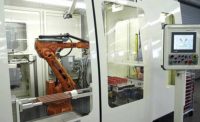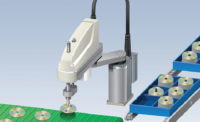Assembling an acoustic guitar of world-class caliber requires more technology than you might realize. Hand craftsmanship is still the hallmark of Taylor Guitars, which has been in business nearly 45 years. But technology now plays a more integral role in both the guitar maker’s groundbreaking designs and the pioneering manufacturing process to produce them.
Taylor Guitars builds premium acoustic guitars at its facilities in El Cajon, CA, and Tecate, Mexico. Renowned for blending innovative manufacturing techniques with an artisan’s attention to detail, Taylor pioneered the use of CNC milling, laser cutting and robotics in guitar construction. Large-payload robots assist with polyurethane spray application and buffing of the wood finishes. Compact, high-speed robots assemble guitar electronics.
High-precision SCARA robots made by Epson Robots help assemble Taylor’s acoustic pickups. A guitar pickup acts like a microphone. When you hit the guitar strings, it creates vibrations. Taylor’s pickup uses the compression from piezoelectric material to sense the vibrations and translate them into electrical signals. Those signals can then be amplified by an acoustic guitar amplifier, mixing board or public address system.
Traditionally, piezoelectric pickups were positioned under the guitar saddle. The Taylor Expression System 2 (ES2) is an innovative pickup design developed by Taylor’s electronics team to enhance acoustic guitar amplification. The heart of the ES2 is Taylor’s patented behind-the-saddle pickup.
While the ES2 pickup improves the guitar’s amplified tone and responsiveness, it complicates the build process. By relocating the pickup behind the saddle, it makes the assembly process more difficult for human fingers, especially with consistency at higher production volumes.
“The Epson robot was brought in primarily to make our acoustic pickups,” says David Judd, a product developer at Taylor Guitars. “I was making them by hand. I could make 10 or 20 a day. At first we needed 100 a day, and then we’ve ramped up to close to 600 a day. So we wouldn’t have been able to do it without automation.”
The piezo blocks are small and have a tight fit in the ES2 pickup assembly, which is tightly wrapped in adhesive. If done by hand with tools, each assembly step increases the possibility of damaging the materials.
Two Epson G3 high-speed SCARA robots handle the intricate assembly work. As a division of Japan-based Seiko Epson Corp., Epson Robots has a history rooted in small parts assembly. In the early 1980s, the company began developing robots to improve the productivity and quality of its in-house watchmaking processes. Today, Epson robots still assemble Seiko watches and Epson printer components.
“We really like the Epson G3 because when you tell it to do something, it does that exactly the same every time,” says Judd.
The assembly process starts with the piezoelectric material fed onto a conveyor from a vibratory feeder. A color-sensing camera determines the polarity of each two-sided piezo block. Any piezo blocks presenting bronze side up are rerouted through the feeder to present with the silver side facing up.
While the camera determines piezo block polarity, a worker inspects and places pieces of the assembly in the pickup molds, which are arranged on a rotary indexing table. The paper backing is removed from the adhesive by automated tooling custom-made by Taylor’s engineers.
Then, an Epson G3 robot places insulation and installs a printed circuit board (PCB). The other Epson robot is equipped with custom end-of-arm tooling to pick three piezo blocks at a time from the conveyor and place them in the appropriate slots of the pickup assembly. Once the piezo blocks and PCB are installed, the pickup assembly is folded and an Epson robot transports the completed assembly to a wrapping station.
Throughout the assembly process, a combination of machine vision cameras and a laser sensor are used to verify correct placement of the piezo blocks, assess final assembly and confirm the presence of components in the pickup assembly.
“As far as features of Epson robots, one thing I like is you don’t need a teach pendant, you can operate the robot’s motion and create programs all directly from a PC,” says Taylor’s robotics engineer Tyler Robertson. “The programming language is flexible enough that we have been able to integrate third party vision systems without much effort, as well as Ethernet communication, which allowed us to avoid a lot of wiring and make the integration of that vision system quite a bit easier.”
Epson RC+ Software has an intuitive graphical interface that significantly reduces programming time. A wide variety of fieldbus interface options are supported, including Ethernet/IP, DeviceNet, Profinet and EtherCAT. An open-architecture environment and easy-to-use options, including integrated vision, force guidance, conveyor tracking, and a GUI builder reduce overall development time.
Taylor Guitars dubbed the robotic assembly cell “Foldy” for the folding process of the pickup assembly.
“We try to nickname robots and machines because it helps people remember what we’re referring to,” says Robertson. “Components move into the system and the assembly is folded together with a combination of robot motion and custom automated tooling.”
He says this iteration of Foldy has been in place for almost two years. Another Foldy iteration has been on the job for over five years.
“It has kept the precision and repeatability over the last five years and we haven’t had to worry,” says Robertson. “We haven’t had to replace any parts. We’ve done virtually no maintenance whatsoever.”
Looking forward to the future, Foldy will have new tooling and equipment implemented as part of continuous improvement. Taylor is also readying a new robot cell for applying adhesives, which will also use an Epson G3 robot as the main motion system.
“Small parts assembly and applying adhesives are perfect applications for SCARA systems,” says Robertson.
Epson G3-Series SCARA robots are the reliable choice for these high-precision applications. The rigid arm design reduces vibration, while Epson’s PowerDrive servo technology yields high-performance results in a compact form factor.
For more information, call Epson Robots at 562-290-5910 or visit www.epsonrobots.com.






